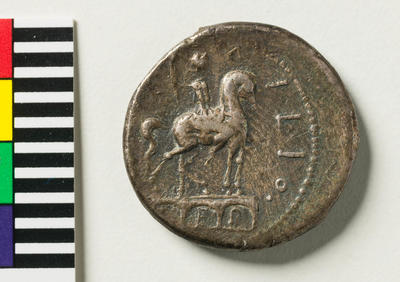Roman Republic Coin. Denarius of M'. Aemilius Lepidus. 114-113 BC.
Production date
0114 BCE-0113 BCE
Country
Italy
See full details
Object detail
Description
Obv: Laureated Roma bust, draped and wearing diadem; ROMA to the right, control mark. Border of dots / Rev: Equestrian statue right, horseman holding spear, base formed by triple arch; L·E·P·MN·AE·M·ILIO· (RRC 291/1)
Classification
NUMISMATICS (COINS AND TOKENS) Ancient Roman Coins
Production date
0114 BCE-0113 BCE
Production place
Measurements
18mm (diameter)
2mm (thickness)
4gm (weight)
2mm (thickness)
4gm (weight)
Media/Materials description
silver
Signature/Marks
L·E·P·MN·AE·M·ILIO
History and use
This denarius was minted by Roman moneyer Manius Aemilius Lepidus, a member of the Aemilii Lepidi (one of the greatest patrician families in Rome). The obverse depicts the laureated personification of Rome (Roma), and the reverse features an equestrian statue on top of an aqueduct, represented by three arches. This aqueduct was started by Marcus Aemilius Lepidus, but finished by Quintus Marcius Rex. The statue was also commemorated in honour of Marcus’ deeds during the Battle of Cannae.
History is contained in the designs and the imagery on coins were used as an opportunity to send messages concerning power, ideology, commemoration, and to bestow honour. Yet, more than that, coins are also dynamic items of material culture. They are small, portable and durable, and have been used for millennia to enable the transaction of goods and services. Coins are also part of everyday life, and unlike other items of material culture, tend not to have one owner; indeed, each coin has been passed through multiple people’s hands through time.
History is contained in the designs and the imagery on coins were used as an opportunity to send messages concerning power, ideology, commemoration, and to bestow honour. Yet, more than that, coins are also dynamic items of material culture. They are small, portable and durable, and have been used for millennia to enable the transaction of goods and services. Coins are also part of everyday life, and unlike other items of material culture, tend not to have one owner; indeed, each coin has been passed through multiple people’s hands through time.
Registration number
N2377



